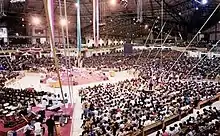Megachurch
A megachurch is a church with an unusually large membership, who also offer a variety of educational and social activities, usually Protestant or Evangelical.[1] The Hartford Institute for Religion Research defines a megachurch as any Protestant Christian church having 2,000 or more people in average weekend attendance.[2][3][4][5]
The concept originated in the mid 19th century, continued onward into the mid 20th century and expanded rapidly through the 1980s and 1990s; in present days it is widely seen across America in the early 21st century.
History

The origins of the megachurch movement, with many local congregants who return on a weekly basis, can be traced to the 1800s.[6][7] There were large churches earlier, but they were considerably rarer. The first evangelical megachurch, the Metropolitan Tabernacle with a 6000-seat auditorium, was inaugurated in 1861 in London by Charles Spurgeon.[8] In the United States, in 1923, the Angelus Temple was inaugurated in 1923 with a 5,300-seat auditorium in Los Angeles by Aimee Semple McPherson.[9]
Current conditions and statistics

.jpg.webp)
In 2010, the Hartford Institute's database listed more than 1,300 such Protestant churches in the United States; according to that data, approximately 50 churches on the list had average attendance exceeding 10,000, with the highest recorded at 47,000 in average attendance.[10] On one weekend in November 2015, around one in ten Protestant churchgoers in the US, or about 5 million people, attended service in a megachurch.[11] 3,000 individual Catholic parishes have 2,000 or more attendants for an average Sunday Mass, but they are not called megachurches as that is a specifically Protestant term.[5]
Globally, these large congregations are a significant development in Protestant Christianity.[12] In the United States, the phenomenon has more than quadrupled in the past two decades.[13] It has since spread worldwide. In 2007, five of the ten largest Protestant churches were in South Korea.[14] The largest megachurch in the world by attendance is South Korea's Yoido Full Gospel Church, an Assemblies of God church, with more than 830,000 members as of 2007.[14][15] The largest church auditoriums, Glory Dome, was inaugurated in 2018 with 100,000 seats, in Abuja, Nigeria.[16]
Criticism
In 2005, Baptist Pastor Al Sharpton criticized megachurches for focusing on "bedroom morals", statements against same-sex marriage and abortion, by ignoring issues of social justice, such as the immorality of war and the erosion of affirmative action.[17]
In 2018, American professor Scot McKnight of Northern Baptist Theological Seminary criticized nondenominational megachurches for the weak external accountability relationship of their leaders, by not being members of a Christian denomination, further exposing them to abuse of power.[18]
See also
References
- "megachurch". Oxford English Dictionary (Online ed.). Oxford University Press. (Subscription or participating institution membership required.)
- "Church Sizes". www.USAChurches.org. Retrieved August 29, 2017.
- Biard, Julia (February 23, 2006). "The good and bad of religion-lite". The Sydney Morning Herald. Retrieved November 5, 2006.
- Bryan S. Turner, The New Blackwell Companion to the Sociology of Religion, John Wiley & Sons, USA, 2010, p. 251
- "Megachurch Definition". Hartford Institute for Religion Research. Archived from the original on 2016-05-14. Retrieved February 6, 2010.
- Anne C. Loveland, Otis B. Wheeler, From Meetinghouse to Megachurch: A Material and Cultural History, University of Missouri Press, USA, 2003, p. 35
- "Exploring the Megachurch Phenomena: Their characteristics and cultural context". Hirr.HartSem.edu. Archived from the original on 2015-11-01. Retrieved February 6, 2010.
- Stephen J. Hunt, Handbook of Megachurches, Brill, Netherlands, 2019, p. 50
- George Thomas Kurian, Mark A. Lamport, Encyclopedia of Christianity in the United States, Volume 5, Rowman & Littlefield, USA, 2016, p. 1471
- "Hartford Institute for Religion Research, database of Megachurches". Hirr.HartSem.edu. Retrieved February 6, 2010.
- "The megachurch boom rolls on, but big concerns are rising too". Religion News Service. December 2, 2015. Retrieved February 1, 2016.
- Anne C. Loveland, Otis B. Wheeler, From Meetinghouse to Megachurch: A Material and Cultural History, University of Missouri Press, USA, 2003, p. 3
- "Redirect". www.SecularHumanism.org. Retrieved August 29, 2017.
- "O come all ye faithful". Special Report on Religion and Public Life. The Economist. November 3, 2007. p. 6. Retrieved November 5, 2007.
- "In Pictures: America's 10 Biggest Megachurches". Forbes. June 26, 2009.
- Taylor Berglund, World's Largest Church Auditorium Dedicated in Nigeria, charismanews.com, December 7, 2018
- Associated Press, Megachurches have wrong focus, black leaders say, chron.com, USA, 2 juillet 2006
- James Wellman Jr., Katie Corcoran, Kate Stockly, Éloi Ficquet, High on God: How Megachurches Won the Heart of America, Oxford University Press, UK, 2020, p. 212